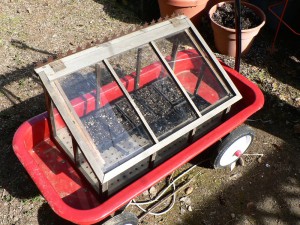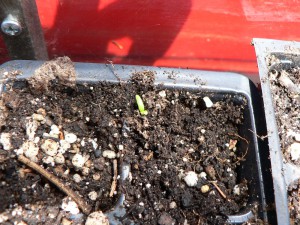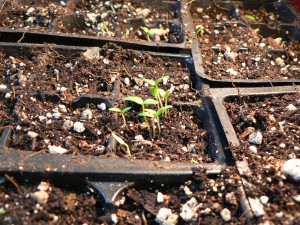On Sunday April 19th I decided to start some of my Japanese indigo seeds. You may recall that I was able to save a substantial quantity last fall. I ought to have started them weeks ago, perhaps even months ago. However, earlier in the spring it was hard to believe that the snow would ever melt so I just couldn’t handle seed starting. This past weekend, it was gloriously warm and it was clear that spring had triumphed at last. So, I figured it was better late than never.
I borrowed a teeny cold frame from school, which has been sitting in the basement over there for years. It needed a little washing and reinforcing. I used our very own compost mixed with potting soil, planted seeds in little six-packs, watered them, and set them in the warm sun. The cold frame is on the wagon is so we can move it around to keep it in the sun, and bring it indoors easily at night.
 Well, to my surprise some seedlings popped up just a couple days later. The weather had stayed pretty warm for a few days, so I wasn’t suspicious at first.
Well, to my surprise some seedlings popped up just a couple days later. The weather had stayed pretty warm for a few days, so I wasn’t suspicious at first.
But then I got suspicious. There were way more seedlings in some pots than the number of seeds I had planted. Ooops. I neglected to consider that our compost is rich with tomatillo seeds left over from our salsa-making endeavors. These are *not* the fastest-sprouting Japanese indigo seeds known to humankind. These are, without a doubt, regular old tomatillo seeds that got excited when it got warm.
To make sure, I looked up some photos of Japanese indigo seedlings at the two-leaf stage (when many seedlings look a lot alike). This blog, Folk Fibers, has lovely photos. There is a pink quality to the stems, even when tiny, that the tomatillos do not possess. Another blog, Wool, also has a good image of Japanese indigo seedlings when small. This fellow is so keen on dyeing with indigo that he was giving away seedlings this winter. (12/28/2023 Edited: Graham isn’t doing a free give-away these days, presumably because of the surging interest in natural dyeing over the past few years. I changed the link to the Wayback Machine’s snapshot from May 2014. But you can buy seeds from him here.)
At the two-leaf stage, in those little peat pots, there’s not much to distinguish the Japanese indigo seeds, but my tomatillo leaves are more narrow. You can see a few more photos here and here.
So, I will obviously need to replant with some seed-free starting medium. Sigh.


